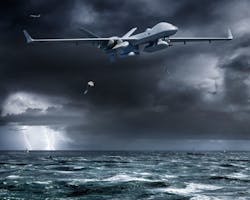Navy and General Atomics developing ASW unmanned aircraft to help P-8A Poseidon with submarine hunting
WASHINGTON – The U.S. Navy and General Atomics in November used sonobuoys dropped from an MQ-9A Block V Reaper unmanned aerial vehicle (UAV) to track a simulated submarine target on a U.S. Navy Pacific test range, in what the contractor says is the first time an aerial drone has deployed a self-contained anti-submarine warfare (ASW) system. Defense News reports. Continue reading original article
The Military & Aerospace Electronics take:
4 Feb 2021 -- The Reaper deployed a mix of 10 sonobuoys -- deployed to measure water conditions and listen for submarine targets -- then received and transmitted the data in real time to a monitoring station at Laguna Flight Operations Facility located at Yuma Proving Ground in Arizona.
The test was part of developing the General Atomics MQ-9B SeaGuardian submarine-hunting UAV. The Reaper managed to acquire and track an expendable ASW training target for three hours using UYS-505 acoustic processing software from General Dynamics Mission Systems in Fairfax, Va.
If the Navy can make this concept of operations work, it has the potential to lower the cost of submarine hunting significantly and free-up larger, more expensive manned sub-hunting aircraft like the P-8A Poseidon for ASW command-and-control.
Related: New era dawns in ASW as manned and unmanned submarines team for bistatic sonar
John Keller, chief editor
Military & Aerospace Electronics
